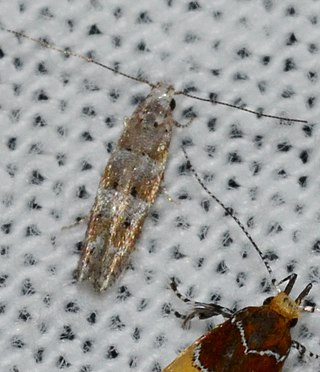
A pine is any conifer tree or shrub in the genus Pinus of the family Pinaceae. Pinus is the sole genus in the subfamily Pinoideae.

Lymantria dispar, also known as the gypsy moth or the spongy moth, is a species of moth in the family Erebidae native to Europe and Asia. Lymantria dispar is subdivided into several subspecies, with subspecies such as L. d. dispar and L. d. japonica being clearly identifiable without ambiguity. Lymantria dispar has been introduced to several continents and is now additionally found as an invasive species in Africa, North America and South America. The polyphagous larvae live on a variety of deciduous and coniferous trees and can cause severe damage in years of mass reproduction. Due to these features, Lymantria dispar is listed among the world's 100 worst invasive alien species.

Pinus sylvestris, the Scots pine (UK), Scotch pine (US), Baltic pine, or European red pine is a species of tree in the pine family Pinaceae that is native to Eurasia. It can readily be identified by its combination of fairly short, blue-green leaves and orange-red bark.

Callidulidae, the only known family of the superfamily Calliduloidea, is the family of Old World butterfly-moths, containing eight genera. They have a peculiar distribution, restricted to the Old World tropics of Southeast Asia to Australasia and Madagascar. The three subfamilies exhibit both day- and night-flying behaviour.

Exoteleia is a genus of moths in the family Gelechiidae.

Exoteleia pinifoliella is a moth of the family Gelechiidae. It is found in eastern North America.

Teleost leptins are a family of peptide hormones found in fish (teleostei) that are orthologs of the mammalian hormone leptin. The teleost and mammalian leptins appear to have similar functions, namely, regulation of energy intake and expenditure.
Dioryctria castanea is a species of snout moth in the genus Dioryctria. It was described by John David Bradley in 1969 and is known from India.
Alexey Nikolaievich Diakonoff, also transliterated as Alexej Nikolajewitsch Diakonoff, was a Russian–Dutch entomologist who specialised in Microlepidoptera.
Emilio Berio was an Italian entomologist and lawyer.

Exoteleia dodecella, the pine bud moth, is a moth of the family Gelechiidae. It is widely distributed from western Europe to Siberia. It is an introduced species in North America.

Argyrotaenia tabulana, the jack pine tube moth or lodgepole needletier moth, is a species of moth of the family Tortricidae. It is found in North America, where it has been recorded from Alabama, Arkansas, British Columbia, Florida, Georgia, Indiana, Louisiana, Maine, Maryland, Massachusetts, Mississippi, New Jersey, New York, North Carolina, Ohio, Oklahoma, Pennsylvania, South Carolina and West Virginia.
Coleotechnites chillcotti is a moth of the family Gelechiidae. It is found in North America, where it has been recorded from Alabama, Louisiana, Maryland, New Jersey, Pennsylvania and South Carolina.
Exoteleia anomala, the ponderoa pine needle miner, is a moth of the family Gelechiidae. It is found in the United States, where it has been recorded from Alabama, Louisiana, Mississippi, New Mexico and Arizona.
Exoteleia burkei, the Monterey pine shoot moth, is a moth of the family Gelechiidae. It is found in North America, where it has been recorded from California.
Exoteleia californica is a moth of the family Gelechiidae. It is found in North America, where it has been recorded from California.
Exoteleia graphicella is a moth of the family Gelechiidae. It is found in North America, where it has been recorded from California.
Exoteleia ithycosma is a moth of the family Gelechiidae. It is found in Guyana.
Exoteleia succinctella is a moth of the family Gelechiidae. It is found in the Alps, on the Balkan Peninsula and in Bulgaria.
Xenolechia ceanothiae is a moth of the family Gelechiidae. It is found in North America, where it has been recorded from Michigan.








